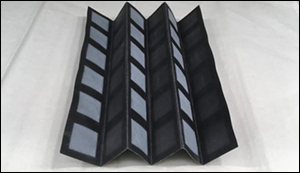Scientists Build Bacteria-Powered Battery on Single Sheet of Paper
21. 12. 2016 | Science Daily | www.sciencedaily.com
Researchers at Binghamton University, State University of New York have created a bacteria-powered battery on a single sheet of paper that can power disposable electronics. The manufacturing technique reduces fabrication time and cost, and the design could revolutionize the use of bio-batteries as a power source in remote, dangerous and resource-limited areas.
On one half of a piece of chromatography paper, researchers placed a ribbon of silver nitrate underneath a thin layer of wax to create a cathode. The pair then made a reservoir out of a conductive polymer on the other half of the paper, which acted as the anode. Once properly folded and a few drops of bacteria-filled liquid are added, the microbes' cellular respiration powers the battery.

Different folding and stacking methods can significantly improve power and current outputs. Scientists were able to generate 31.51 microwatts at 125.53 microamps with six batteries in three parallel series and 44.85 microwatts at 105.89 microamps in a 6x6 configuration.
It would take millions of paper batteries to power a common 40-watt light bulb, but on the battlefield or in a disaster situation, usability and portability is paramount. Plus, there is enough power to run biosensors that monitor glucose levels in diabetes patients, detect pathogens in a body or perform other life-saving functions.
Read more at Science Daily
Image Credit: Seokheun
-jk-




